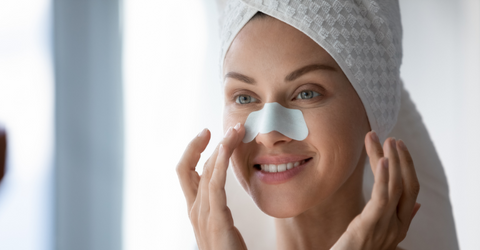In the intricate world of skincare, blackheads and sebaceous filaments often look-alikes in appearance leaving us befuddled in front of the mirror. Yet, beneath their superficial resemblance lies a world of difference. Let's unravel the mystery and distinguish between the two.
What are Blackheads?
Blackheads, those tiny black dots that dot our T-zones, are essentially a type of acne clogging hair follicles, your skin’s natural oil and sebum or sebaceous (oil) glands. Unlike pimples, blackheads are not as painful or irritated since they are flat, dark spot on the skin and can happen for various reasons from excess sebum to hormones or the overproduction of skin cells.
While teenagers often have blackheads, they're not exclusive to any age group. They appear on our nose, chin, and forehead, and unfortunately also develop anywhere on the body.
What is a Sebaceous Filament?
Now, let's talk about sebaceous filaments. Those tube-like structures are formed when oil is produced around the hair follicle. Nevertheless, they are a normal part of the skin’s moisturising process and move oil to the skin’s surface. Unlike blackheads, sebaceous filaments moisturise and nourish the skin rather than clog it.
For the lucky ones, sebaceous filaments will remain hidden since these filaments only become visible when the lining of your pore fills up with sebum. However, for those with oily skin or enlarged pores, sebaceous filaments can be more visible like blackheads, and more of a light grey or tan, rather than black. In some cases, sebum can be thick and waxy, which looks like blackheads but is rather dead skin cells and oil in the pore.
Difference Between Blackheads and Sebaceous Filaments?
Distinguishing between the two is like paying 7 Errors. Here's a quick cheat sheet:
Blackheads
- Blackheads are a type of acne, clogged with dead skin, skin’s natural oil and oxidised sebum, appearing as dark dots.
- They mostly occur in t-zone areas. Blackheads tend to cluster in the T-zone—forehead, nose, and chin—where larger pores and increased sebum production create ideal conditions for their formation.
- They are darker in colour. The dark coloration of blackheads arises from oxidation as trapped oil and debris interact with air, with melanin in the skin contributing to the dark hue.
- If a blackhead is removed, it likely will not reappear again. Successfully extracted blackheads typically do not return, as the contents are expelled from the pore, although new blackheads can form nearby without proper skincare maintenance.
- Blackheads are normally larger in size. Compared to other acne lesions, blackheads often appear larger due to the gradual accumulation of oil, dead skin cells, and bacteria within the pore.
- They are raised bumps. While blackheads may seem raised upon close inspection, they typically maintain a relatively low profile on the skin compared to inflammatory acne lesions.
- Squeezing blackheads is very harmful. Squeezing blackheads can lead to skin irritation, inflammation, and scarring, as well as the deeper penetration of bacteria into pores, best avoided by gentle skincare methods or professional treatment.
Sebaceous filament
- Sebaceous filaments are completely healthy and are a natural part of the skin. These filaments play a crucial role in maintaining skin health by facilitating oil distribution and moisturization, contributing to overall skin balance and hydration.
- They are pale, sandy and grey small spots. Sebaceous filaments typically manifest as tiny, lightly-coloured dots on the skin's surface, often resembling fine grains of sand or a faint grey hue.
- Sebaceous filaments mostly occur in isolated areas such as the nose and chin. These filaments are commonly found in regions with larger pores, such as the nose and chin, where they help regulate sebum production and maintain skin moisture levels.
- They are lighter in colour. Unlike blackheads, sebaceous filaments exhibit a lighter, less conspicuous coloration, blending in more seamlessly with the surrounding skin tone.
- Sebaceous filament is a normal part of skin and that can reappear in about 30 days. Due to the skin's natural renewal cycle, sebaceous filaments can regenerate approximately every 30 days, persisting as an inherent aspect of skin physiology.
- Sebaceous filaments are smaller in size. Compared to blackheads, sebaceous filaments are typically smaller and less prominent, presenting as subtle, flat dots on the skin's surface.
- Squeezing sebaceous filaments is harmful. Attempting to extract sebaceous filaments through squeezing can exacerbate pore congestion, inflammation, and potential scarring, emphasising the importance of gentle skincare practices for optimal skin health.
How to Treat Blackheads?
To get rid of blackheads, using a variety of over-the-counter products works. Blackhead solutions typically contain salicylic acid, benzoyl peroxide, and resorcinol; ingredients that work well to kill bacteria, remove excess oil, and help the skin to shed dead skin cells.
Antioxidants like vitamin C prevent blackheads by reducing sebum oxidation which causes the dark colour of a blackhead. AHA & BHA clear any congestion that lies within the pores and dissolve sebum and dead skin. But before using these skincare products beware not all skincare ingredients play well together, thus learn first which ingredients are safe to use together.
How to Treat Sebaceous Filaments?
For sebaceous filaments, gentle treatments reign supreme. To minimise the appearance of sebaceous filaments, include salicylic acid, benzoyl peroxide, tea tree oil, and sun protection.
In addition, the excess sebum production that leads to sebaceous filaments can be prevented before it occurs by consistently (once a week) cleansing your face, avoiding harshly scrubbing any affected areas, using oil-free and alcohol-free skincare products, moisturising daily, and choosing gentler skincare products.
Solutions
As we navigate the labyrinth of our pores, let's embrace the nuances that make our skin unique. We’ve all been there: in full magnifying mirror mode, examining every single pore, bump and spot on our face to find out whether it is blackhead or sebaceous filament.
Above, we share the differences between sebaceous filaments vs. blackheads, what causes each, and the best treatments.
Armed with the wisdom of blackheads vs. sebaceous filaments, we embark on a journey of self-discovery—one pore at a time.





Comments (0)
There are no comments for this article. Be the first one to leave a message!